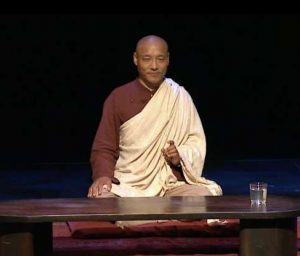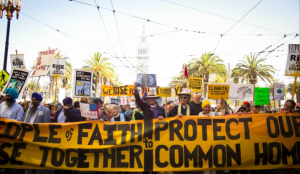
There is a Pali word commonly used in several Theravada Buddhist countries for a person who has chosen the homeless lifestyle: an anagārika, a “homeless one.” These are individuals who have chosen to go forth into a life of homelessness out of spiritual conviction and a desire to walk the path of the samaṇa (Pali. ascetic). Yet people who find themselves forced into homelessness are almost always in distressing and unbearable circumstances, particularly those trapped in long-term homelessness. Homelessness is classed by the United Nations as a human rights violation. The Buddhist theory of monastic homelessness as a carefully considered choice is worlds apart from the contemporary definition as an experience of “not having stable, safe, and adequate housing, nor the means and ability of obtaining it.” (United Nations Office of the High Commissioner)
No one should accept the lack of safe and stable housing as a natural or inevitable part of human society. The UN definition of homelessness as the deprivation of a basic human right is far from new. Homelessness violates Articles 1 and 22 of the UN Declaration on Human Rights. On top of the problem of not having safe and secure shelter, homelessness comes with an entire set of additional burdens for the victim, such as social ostracism and stigma, exposure to physical danger and harm, and being treated like a criminal.
Finland is one country that has taken radical steps toward addressing homelessness, even though the crisis there is less severe than in many other nations, aiming to completely eradicate homelessness by 2027. This success has not come overnight. Since 2008, Finland has adopted a national policy based on a “Housing First” philosophy, advocating that providing permanent housing should be the first priority in solving the crisis. Therefore, over many years, homeless shelters have been converted into comfortable, permanent homes, with employed staff helping those with addictions, facilitating life skills training, and helping people to find work placements. Canada’s The Globe and Mail newspaper reports: “Housing First advocates say that research has shown stable housing for all people has proven to be the most effective remedy, both for improving lives and saving money.” (The Globe and Mail)
Finland’s Housing First model is based on a simple premise: give the homeless homes and there will be fewer homeless people. In other words, “All the work done for homeless people starts from the assumption that the first support measure should be the provision of housing. The work can be organized using different models and by providing different kinds of housing, but housing is always the top priority.” (Housing First in Finland)
Housing First not only reverses the cause and effect of homelessness, but takes a holistic, compassionate approach to offering a solution. This is the furthest thing from a simplistic or naïve aspiration. It is, in a manner of speaking, looking at the hetupratyaya of what leads to homelessness in a society. In Buddhism, hetupratyaya is a Sanskrit term meaning “causes and conditions” or “causality,” and applies to everything in the physical, emotional, and spiritual realms. (Buswell Jr. and Lopex Jr. 2014, 348) A certain result arises when causes and conditions come together. In applying this principle to our lives and our world, holistic interconnectedness is a given. Homelessness is no different. As Housing First advocates declare: “Defining homelessness in a broader sense helps recognize and consider all different paths that can lead to homelessness. A person can end up homeless due to several reasons, such as substance abuse or illness, for example. A homeless person may be a young secondary school student or an alcoholic senior citizen.” (Housing First in Finland)
The result is a long-term solution that saves money. As Juha Kaakinen of the Finnish Housing First development organization Y-Foundation argues: “When a homeless person gets a permanent home, even with support, the cost savings for the society are at least €15,000 [US$17,700] per one person per one year. And the cost savings come from different use of different services.” (CBC)
Kaakinen notes that the cost of homeless people using services such as emergency healthcare, the police, and the justice system far outstrips the cost of people receiving proper housing. Contrast this with the most recent homelessness expenditure statistics released in England in October 2020, in the midst of the pandemic: “Councils [in England] spent almost £1.2 billion [US$1.65 billion] providing temporary accommodation for homeless households between April 2019 and March 2020. This has increased by 9 per cent in the last year and 55 per cent in the last five years.” (Shelter) And of this considerable total spent on temporary accommodation by councils in England alone in 2020, 87 per cent went to private landlords, letting agents, and companies.
England and most of its European neighbors have far larger populations than Finland,* and so homeless numbers there are inevitably higher. However, comparing England’s policy of spending on short-term housing with Finland’s longer-term outlook on resolving homelessness and the moral is clear: “The message from homeless people about homelessness has always been that it has to be a permanent housing, a safe place—not a shelter or a hostel,” said Kaakinen. (The Globe and Mail) Finnish state policy (and political will) of ensuring at least 25 per cent affordable social housing in any new housing area also makes a difference when compared with other European nations.
In a declaration to combat homelessness launched on 21 June, the European Commission’s commitments identified factors that align quite closely with Finland’s decades-long policy:
• No one sleeps rough for lack of accessible, safe and appropriate emergency accommodation;
• No one lives in emergency or transitional accommodation longer than is required for successful move-on to a permanent housing solution;
• No one is discharged from any institution (e.g. prison, hospital, care facility) without an offer of appropriate housing;
• Evictions should be prevented whenever possible and no one is evicted without assistance for an appropriate housing solution, when needed;
• No one is discriminated due to their homelessness status. (EU Commission)
There are encouraging signs that the Housing First model is beginning to be replicated outside of Finland, including in the EU, Asia, and North America. Finland’s accomplishment has been to confront the issue head-on, including the self-evident fact that there is homelessness because, for complex societal and economic reasons, people have nowhere to live. It would seem that in order to realize the EU Commission’s definition of ending homelessness, policymakers and advocates should attack the “root cause” of homelessness, while also stepping back and examining the causal factors of this complex social blight and source of suffering. The result has been less wasted money funneled toward private profiteers and short-term solutions, while homeless people themselves have a real opportunity to become equal stakeholders in society thanks to the compassion and enlightened values of the government, non-profit, and private sectors.
* As of September 2020, the total number of homeless in England was estimated to be 242,070 when both male and female households registering as homeless were combined, while in Finland the total number of homeless households was around 4,542 in the same year.
References
Buswell Jr., Robert E.. and Donald S. Lopez Jr. (eds.). 2014. The Princeton Dictionary of Buddhism. Princeton and Oxford: Princeton University Press.
See more
Homelessness and human rights (United Nations Office of the High Commissioner)
‘Simply not an option’: How Finland is solving the problem of homelessness (The Globe and Mail)
Housing is a human right: How Finland is eradicating homelessness (CBC)
Housing First in Finland
Bill for homeless accommodation soars to £1.2 billion (Shelter)
European platform to combat homelessness is launched (European Commission)
(Shelter)
Four graphs showing the state of homelessness in England (Inside Housing)
Report 2021: Homelessness in Finland 2020 (The Housing Finance and Development Centre of Finland)
Related features from Buddhistdoor Global













